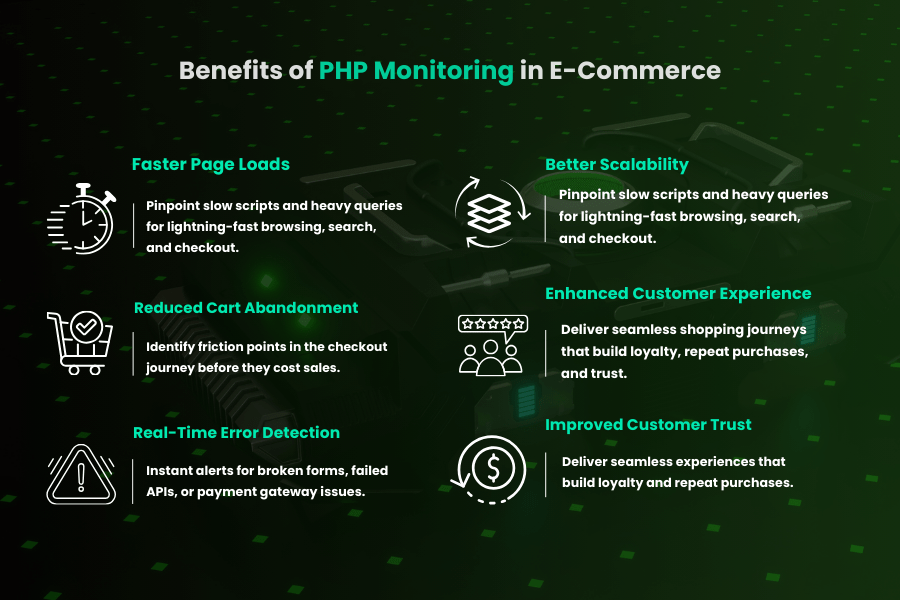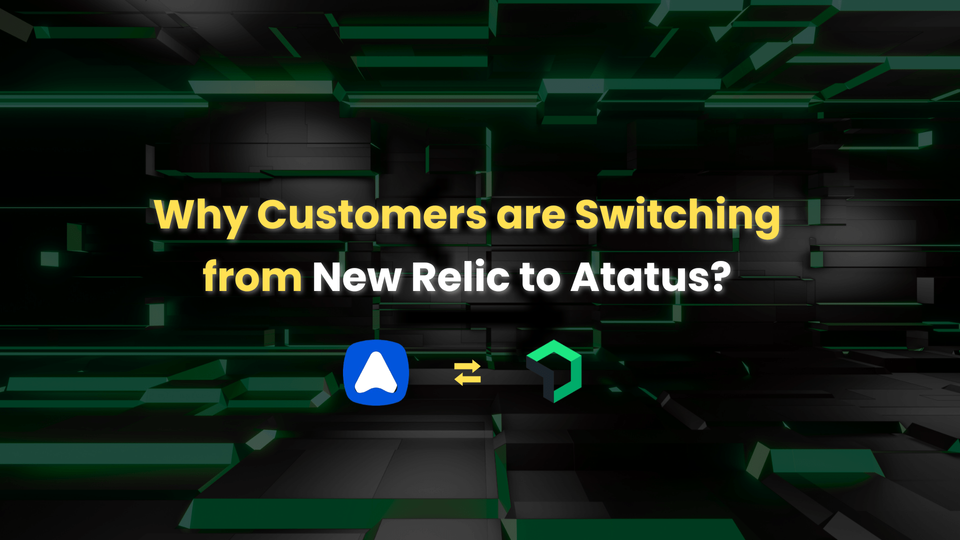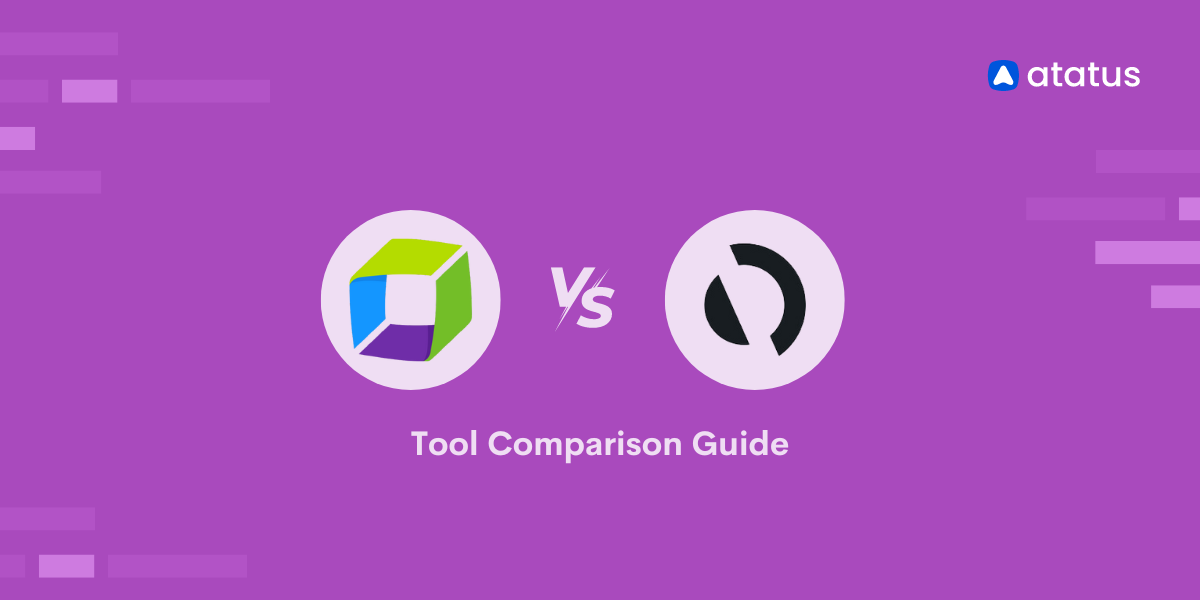Optimize Your E-Commerce Platform with PHP Performance Monitoring
In e-commerce, seconds can mean millions. A one-second delay during checkout can slash conversion rates by 7% and send frustrated customers straight to your competitors. Most modern e-commerce platforms, such as Magento and WooCommerce, and Laravel-based solutions, run on PHP, making PHP application performance monitoring (APM) not just a nice-to-have, but a revenue-critical necessity.
The truth: Monitoring PHP in e-commerce isn’t about just keeping the site up. It’s about ensuring seamless checkouts, fast page loads, accurate inventory updates, and uninterrupted integrations with payment gateways, shipping APIs, and marketing tools. Without the right monitoring, a minor PHP bottleneck can snowball into abandoned carts, customer complaints, and lost trust.
What’s in this article?
- Why PHP Monitoring Is Essential for E-Commerce?
- Key Performance Considerations for E-Commerce Platforms
- Benefits of PHP Monitoring in E-Commerce
- Common E-Commerce Challenges and How PHP Monitoring Solves Them?
- Why Atatus PHP Monitoring Is the Best Choice for E-Commerce?
- FAQs on PHP APM for E-Commerce
Why PHP Monitoring Is Essential for E-Commerce?
PHP monitoring is vital for e-commerce as it ensures fast load times, stable checkouts, and uninterrupted service during high-traffic events. It helps detect and fix performance issues before they affect shoppers, safeguards revenue during peak sales, and reduce development teams burdens which allows them to focus on improving the store experience.
For e-commerce teams, PHP monitoring directly impacts three pillars of success:
- Customer Experience: Shoppers expect page loads in under 3 seconds. Anything slower feels broken.
- Revenue Protection: Downtime during a high-traffic sale (think Black Friday) means real money lost.
- Operational Efficiency: Without visibility, developers waste hours by chasing bugs instead of building features.
A robust PHP monitoring setup ensures your platform is:
- Always available: Detect and resolve issues before they escalate.
- Always fast: Optimize query performance, server-side logic, and API calls.
- Always scalable: Handle spikes in traffic without collapse.
Key Performance Considerations for E-Commerce Platforms
Monitoring a PHP-based e-commerce site isn’t the same as monitoring a regular web application. The stakes are higher for every second of delay or failed request can directly result in lost revenue, abandoned carts, and brand damage.
Here are three critical areas you need to watch closely:
- User Experience & Checkout Flow Optimization
In e-commerce, every step of the journey matters. Treat browsing → cart → checkout → payment → confirmation as a seamless flow. PHP performance monitoring helps identify slow pages, cart update delays, or checkout errors in real-time, ensuring each stage loads quickly and works flawlessly.
By reducing friction and latency across this flow, businesses can lower abandonment rates, boost conversions that deliver a smooth and trust-building shopping experience.
- Scalability Monitoring
E-commerce traffic is highly unpredictable and it surges during sales events, product drops, or viral marketing campaigns. Without proper load and scalability monitoring, servers can crumble under demand.
- Payment Gateway & Third-Party API Monitoring
E-commerce platforms rely on external services for critical functions: payment gateways, shipping calculators, tax services, fraud detection, and CRMs. If any of these slow down or fail, the impact is immediate and visible to the shopper.
Benefits of PHP Monitoring in E-Commerce
For ecommerce applications, every second of downtime or lag can translate into lost sales and frustrated customers. PHP monitoring empowers e-commerce businesses to stay ahead of performance issues and deliver a consistently smooth shopping experience.

- Faster Page Loads
Every extra second a page takes to load increases the chances of a customer abandoning the site. PHP monitoring helps you pinpoint slow scripts, heavy queries, or inefficient code paths, allowing you to optimize them for lightning-fast product browsing, search, and checkout.
- Reduced Cart Abandonment
A flawless checkout journey is essential for conversions. By continuously tracking PHP performance across the browsing → cart → checkout → payment → confirmation flow, you can identify friction points such as slow cart updates or payment delays and fix them before they cost you sales.
- Real-Time Error Detection
When APIs fail, forms break, or payment gateways throw errors, the impact is immediate and costly. PHP monitoring alerts you instantly to such issues, enabling your team to resolve them before they disrupt transactions or damage customer trust.
- Better Scalability During High Traffic
Flash sales, festive seasons, and promotions can cause traffic spikes that overwhelm unprepared systems. PHP monitoring helps you analyze server load, optimize resource usage, and maintain stability, ensuring your site remains fast and responsive no matter the demand.
- Enhanced Customer Experience
From quick product searches to smooth navigation, PHP monitoring ensures customers enjoy a frictionless experience. This leads to higher engagement, repeat purchases, and stronger brand loyalty.
- Improved Customer Trust and Retention
Consistently delivering a seamless shopping experience builds brand loyalty. With PHP monitoring, you can maintain uptime, speed, and functionality, which translates into higher repeat purchases and stronger customer relationships.
Common E-Commerce Challenges and How PHP Monitoring Solves Them?
Running an e-commerce platform means balancing speed, stability, and scalability while handling thousands of dynamic interactions every second. These challenges aren’t just technical, they directly impact sales, customer trust, and brand reputation.
Below are the most common hurdles e-commerce teams face, along with how PHP monitoring addresses them.
| Challenge | Why It Happens in E-Commerce? | How PHP Monitoring Solves It? |
|---|---|---|
| Slow Page Loads During High Traffic | Sudden surges from promotions or product launches overload PHP processes, databases, and caches. | Tracks response times and identifies bottlenecks at the code, database, or server level so teams can scale resources and optimize before users are affected. |
| Checkout Failures | Inefficient PHP logic or slow API calls to payment gateways can cause timeouts and incomplete orders. | Provides transaction-level tracing to pinpoint exactly where the checkout flow stalls, enabling quick fixes without guesswork. |
| Unseen Errors in Production | Minor PHP exceptions may go unnoticed until they impact multiple customers. | Captures detailed error reports with stack traces, user context, and timestamps so issues can be resolved proactively. |
| Third-Party API Delays | Payment, shipping, or fraud detection APIs slow down during peak hours. | Monitors API latency in real time, alerting teams to spikes so they can apply workarounds or fallback processes. |
| Database Query Bottlenecks | Large product catalogs, inefficient queries, or missing indexes slow critical operations like search or cart updates. | Tracks and ranks slow queries, helping developers target and optimize the most impactful ones. |
| Scalability Uncertainty | Without historical data, it’s difficult to predict infrastructure needs for peak events. | Uses performance trends to forecast demand, ensuring adequate PHP workers, database connections, and caching capacity. |
Why Atatus PHP Monitoring Is the Best Choice for E-Commerce?
E-commerce is a high-speed, high-stakes environment where every click, every query, and every API call counts. Atatus PHP Monitoring is built to give engineering and operations teams the depth of insight, speed of detection, and precision of action they need to keep revenue flowing and customers happy.
- Deep Transaction Visibility
Atatus traces every PHP transaction from start to finish whether it’s a product page load, an “Add to Cart” action, or a payment gateway call. This helps teams quickly pinpoint exactly where delays occur, right down to a specific function, query, or API request.
Example: If checkout stalls, you’ll see whether the slowdown came from the cart calculation logic, an external tax API, or the database.
- Real-Time Error Detection
In e-commerce, silent failures are dangerous. Atatus instantly captures PHP errors and exceptions in production with complete stack traces, request data, and user context to reproduce and fix issues before they impact large numbers of customers.
- Third-Party API Monitoring
Payment gateways, shipping APIs, and inventory systems can become bottlenecks without warning. Atatus monitors their performance and availability, alerting you to latency spikes or failures so you can act before they disrupt sales.
- Security & Fraud Anomaly Detection
Spot unusual transaction patterns, suspicious login activity, and abnormal API behavior in real time to protect customer trust and reduce fraud risks.
- Database Performance Insights
Large product catalogs and heavy search traffic can stress databases. Atatus identifies slow queries, missing indexes, and inefficient joins, allowing developers to optimize the biggest pain points for faster page loads and smoother cart updates.
- Scalability & Peak Traffic Readiness
Historical trend analysis and live metrics in Atatus help you anticipate capacity needs before major events like Black Friday or seasonal launches. You can confidently scale infrastructure knowing you have the data to back decisions.
- E-Commerce-Friendly Dashboards
Atatus’ dashboards can be customized to track e-commerce KPIs like checkout completion rate, cart abandonment due to errors, API response times, and average product page load times to monitor what matters for revenue.
Get Started!
In e-commerce, performance issues don’t wait, and neither should you. Atatus gives you the visibility, speed, and confidence to keep every transaction fast and error-free without worrying about the load.
Start Your Free Trial or Request a Demo Today and make downtime a thing of the past.
FAQs on PHP APM for E-Commerce
How does PHP monitoring help prevent revenue loss during peak sales?
- Detects slow queries, failing APIs, and server bottlenecks instantly.
- Alerts teams before performance dips impact shoppers.
- Optimizes checkout flow to keep conversions steady.
What metrics matter most when monitoring PHP applications?
- Response time (average & percentiles)
- Throughput (requests per second)
- Error rate & exception types
- Database query time & frequency
- Memory usage & CPU load
- Slowest transactions & endpoints
How does PHP monitoring reduce downtime costs?
Proactive PHP monitoring detects anomalies before they escalate, pinpoints root causes quickly, and prevents long outages. This reduces revenue loss, avoids operational slowdowns, and ensures teams spend less time firefighting and more time delivering value.
How can PHP monitoring improve customer experience on high-traffic sites?
- Faster page loads with optimized queries
- Fewer checkout errors through real-time error detection
- Consistent uptime during traffic spikes
- Smoother navigation via performance tuning
- Reduced cart abandonment with quick fixes
How does PHP monitoring help with scaling during seasonal traffic spikes?
By analyzing live performance data, PHP monitoring spots bottlenecks early, forecasts capacity needs, and informs scaling decisions. This ensures websites remain responsive, stable, and capable of handling sudden surges in demand without user disruptions.
#1 Solution for Logs, Traces & Metrics
APM
Kubernetes
Logs
Synthetics
RUM
Serverless
Security
More





